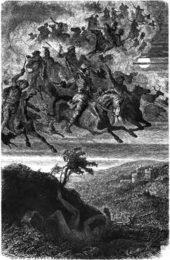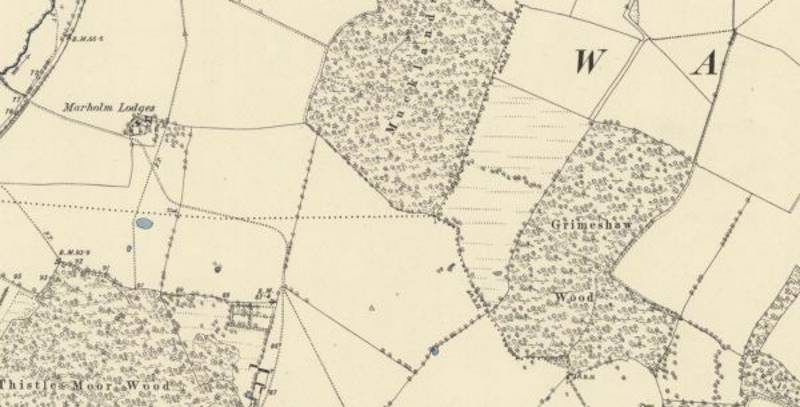What is the Wild Hunt? Essentially a charismatic and awfully powerful spirit, usually with unpleasant leanings, takes evil followers on a hunt through the dark, continually blasting his horn. Hunt leaders have included the Devil, Odin, local bogeymen and notorious spirits of the dead. What does the hunt do? Well, that is trickier to answer. In some stories they chase down evil men; in others they just keep everyone indoors, hiding under their beds.
There are literally scores of medieval and early modern references to the wild hunt from western Europe. What makes the events of 1127 unusual is the quality of the evidence and its early date. We have two separate sources recording the extraordinary events of that spring: one contemporary and one written by an author who, though writing as much as a generation later, had lived through the terror.
The two sources were both written at the Monastery of Peterborough, a Benedictine house and one of England's most important medieval foundations. Both are included below in translation and with the original languages, a very late Old English and a very medieval Latin. The first was a chronicle of the year events and was clearly based on interviews (too portentous a word?) with those who had seen or heard the hunt. The hunt had passed through the monastery's deer park and had arrived as far as fifteen miles away in the woods near Stamford.
The second was a history of the monastery written by Hugh Candidus as much as a generation after the events described there. But Hugh, who had been born in the very late eleventh century and who spent all his life in the monastery, had certainly lived through the events of 1127. Hugh's account does not have any new information about the hunt. But the very fact that Hugh included it, shows that, as he was polishing his history, perhaps in the 1150s, it was still a newsworthy event.
However, here we must add another important consideration. The Chroniclers and later Hugh included the information, not for its Fortean value, but because of an important event in the history of the Monastery. In 1127 a new abbot arrived, a grasping s-o-b called Henry de Angeli. Henry had bought the monastery and was not greatly loved by the monks. The Wild Hunt began immediately after Henry arrived and was, therefore a sign of divine disapproval for this Simoniac.
All this suggests that the Wild Hunt might not have been that remarkable at all. It is all too possible that the good folk of Peterborough and Stamford were forever hearing horns at night and seeing bogeys out in the wood. As always with supernatural events, these would have come and gone in cycles. It was just that this cycle suited the narrative that the monks in the monastery were creating and so was jumped upon.
In other words we don't have here a truly exceptional event, what is exceptional is that the monks pull back the curtains and give us a glimpse of twelfth-century English woods and English folk beliefs. The image below is a 19C map of the haunted area. The closest we will ever come to running from the wild hunt in 1127. Note Grimeshaw Wood - the Goblin's Wood?1127
Ne þince man na seillice þ we soð seggen for hit wæs ful cuð ofer eall land þ swa radlice swa he þær com þ wæs þes Sunendæies þ man singað EXURGE QUARE O. D. þa son þær æfter þa sægon & herdon fela men feole huntes hunten. Ða huntes wæron swarte & micele & ladlice. & here hundes ealle swarte & bradegede & ladlice. & hi ridone on swarte hors & on swarte bucces. Wis wæs segon on þe selue derfald in þa tune on Burch & on ealle þa wudes ða wæron fram þa selua tune to Stanforde. & þa muneces herdon ða horn blawen þ hi blewen on nihtes. Soðfestemen heom kepten on nihtes. sæidon þes þe heom þuhte þ þær mihte wel ben abuton twenti oðer þritti horn blaweres. Wis wæs sægon & herd fram þ he þider com eall þ lented tid on an to Eastren. Wis was his ingang. of his utgang ne cunne we iett noht seggon. God scawe fore
"Let it not be thought remarkable, the truth of what we say, because it was fully known over all the land, that immediately after [Henry] came there (that was the Sunday when they sing 'Awake, why sleepest though, O Lord?') then soon afterwards many men saw and heard many huntsmen hunting. The huntsmen were black and huge and loathsome, and their hounds all black and wide-eyed and loathsome, and they rode on black horses and on black billy-goats. This was seen in the very deer-park of the town of Peterborough, and in all the woods there were from that same town to Stamford; and the monks heard the horns blow that they blew in the night. Honest men who kept watch in the night said that it seemed to them there might well have been about twenty or thirty horn-blowers. This was seen and heard from when he came there, all that Lenten-tide right up to Easter. This was his entrance: of his exit we cannot yet say. May God provide!"Hugh Candidus
Eodem anno cum uenisset ad abbaciam, uisa sunt et audita monstra per totam quadragesimam, et in noctibus, et per siluas et per plana a monasteriousque ad stanford. nam uisi sunt quasi uenatores cum cornibus et canubis, set omnes nigerimi errant et equi eorum et canes, et aliqui quasi edos equitabant, et oculos grandes habebant, et erant quasi uiginti aut triginta simul. Hoc non est falsum, quia plurimi ueracissimi homines uiderunt et audierunt cornua.
"In the very year in which [Henry] came to the abbey, wonderful portents were seen and heard at night during the whole of Lent, throughout the woodland and plains, from the monastery as far as Stamford; for their appeared, as it were, hunters with horns and hounds, all being jet black, their horses and their hounds as well, and some rode, as it were, on goats and had great eyes and there were twenty or thirty together. And this is no false tale, for many men of faithful report both saw them and heard the horns."Update: Bruce T with an enjoyable conspiracy theory 'Do you think it was hoax got up to by a few monks and unhappy tenants to discredit and get rid of a hated Abbot? It would be dead easy to do in a countryside before electricity and other decent illumination on dark nights. The tenant confederates could be eyewitnesses to the demonic hunt , if not active participants in it running around the countryside raising Hell and blowing horns in the middle of the night. If they're spotted they've got the monks on the spot to vouch for them with the easy excuse that they were out to track down the demon horde down.'





The 'illness' without diagnosis is a case of questionable sanity or word, and so many cling to diagnosis that condemn them in sickness but save them from fear of madness and all that entails.
That already fearfully identified people can be manipulated in the fears is secondary.
Fear is a manipulated mind in attempt to conceal its own divisions and conflicts.
The physical mind is more a definition in physical terms of qualitative communication that cannot be thus reduced without seeing the particle/particular at cost of blindness to the field.
Entanglements are where the same thing operates different phases and so can seem different things, at different times at different places. The focus on defining the 'different' is the discarding, ignoring and denial of the 'same'.
Denied fears - and guilt - are protected by the superstructure of thought (mind) that masks or covers over - as if to escape, or 'get away with it'. The 'adam' in division is the positively and negatively charged ion. the forces of which embody as the fields we know, and the fields that we don't know we know.
When that which is the More of who we are arises to our 'conscious' awareness, it may be seen as threat or through the veil of fear and denied guilt. A passing moment can soon be dismissed by a restored continuity management, as can the experience and communication of ancestral memory to the desire to forget.
The sport of the hunt is the thrill and tension of the chase and the release in the kill or capture. This is no less electrically charged than sex - but it is energetically compelled as as such has a demonic or unconscious disregard or blindness to the qualitative characteristic of it charged fantasy object.
How one interprets dreaming is relative to the active them of desire and intention. Assigning to the 'devil' the feared and the hated is of course to give power to denial. 'Don't know' mind or beginner's mind, is not naive, so much as innocent of framing that sets a narrative persona in terms of already existing identity. To not presume to already know is to open to the discernments of subtler qualities that are in truth, where power is being, however personal of mass hallucinations may assert power to be - and suffer it!